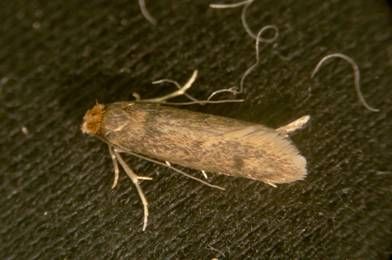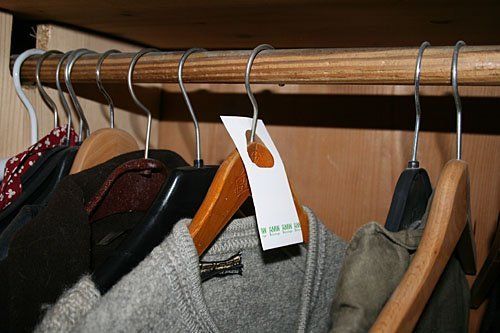It always affects only the best clothes! The larvae of the clothes moth (Tineola bisselliella) love to eat holes in wool clothing. Often the damage is only detected when the feeding damage becomes visible or moths fly around. The larvae of the clothes moth are the main pest in our wardrobe. Besides the damage in the fabric, the 10 mm long, whitish cocoon tubes of the larvae are another sign for an infestation by clothes moths. The larvae can only develop on animal wool, that is why they infest especially high quality woolen materials.
The eggs laid by the female moths are about 0.5 mm long, white and only hard to find in the fabric. The young larvae are about 1 mm in size and of yellowish white color.
The flight of the clothes moth can be controlled by means of a pheromone trap. The moths themselves do not eat (they have atrophied mouthparts), they die after the oviposition. A female moth lives at room temperature for up to 14 days.
The control of the clothes moths is more difficult than the one of the food moths as the clothes moth has a much longer development time and the parasitic wasps have to search a very large surface (folded pullovers in the wardrobe, confusion by fine fluffy wool like mohair etc.).
Clothes moths prefer dark and quiet hiding places in dry and warm rooms. During their lifetime, the females lay up to 250 eggs on textiles, fur or feathers. The larvae feed on preferably keratin-containing (animal) products like real wool, hair or feathers. From these materials the larva constructs its cocoon tube for pupation. Clothes moths also infest carpets, fillings of old furniture, wall decoration, animal fur, trophies, etc.



Appearance of the clothes moth:
The 5-10 mm long and delicate moths have a grey-yellow color and fringes at the hindwings and forewings. The final size of the larvae just before pupation is max. 10 mm.
Way of life of the clothes moth:
At temperatures between 25 and 30°C and a humidity of 70 % the larvae develop in about 2 months into pupae. Generally up to 2 generations develop per year. The clothes moth is a mere material pest. The larvae can chew wool, fur, feathers and textiles in furniture and wall coverings with their strong jawbones.
A damage can be prevented by taking a few simple measures:
- Always air or wash worn clothes. Sweat residue attracts the clothes moths.
- Keep wardrobes closed, the currently very popular open dressing rooms facilitate infestation by clothes moths.
- Control valuable and rareley worn clothes regularly for infestation and keep them in garment bags or containers.
- Regularly vacuum clean natural wool carpets thoroughly.
- Control infestation by means of a pheromone trap. Attention: Only male moths are trapped!



Use of parasitic wasps against clothes moths:
The Trichogramma parasitic wasps are natural antagonists of the clothes moths. They feel most comfortable at temperatures above 20°C and are then most effective. The parasitic wasps have an excellent sense of smell and can localize the laid eggs by means of tiny parts of wing scales that the female moths lose when they lay eggs.
The control of the clothes moth with parasitic wasps is carried out over a period of 16 weeks.
As the beneficial insects only have a limited lifetime, they are newly sent 6-8 times at 14 day intervals and replace the old cards. With each release, 4 TrichoKarten, each fitted with parasitic wasps eggs, are distributed in the wardrobes. Trichogramma parasitic wasps are egg parasites, that is they look for the laid eggs of moths, lay their own eggs inside them and instead of a moth larva a new beneficial parasitic wasp hatches. This cycle repeats as long as there are moth eggs available. The parasitic wasps are only interested in the moth eggs. When the work is done, they die and disappear inconspicuously in the house dust. They are neither dangerous for humans nor for pets.
In closed rooms the use is possible all year round. The parasitic wasps can only be stored for a short time. Afterwards they hatch, therefore use them immediately on receipt. Please do not open the cards. The side opening is sufficient for the small animals.
The control of the clothes moth is more difficult than the one of the food moth. The development cycle is much longer and it is often not easy to localize the source of infestation. Clothes moths can also have settled in carpets or old pieces of furniture. The control should only be started after a consultation.



Application of the TrichoKarten: per compartment with approx. 60-80 cm width and 50 cm height: 1 TrichoKarte each.
Infested textiles can be stored concentrated in one part of the wardrobe. All other textiles (cotton and synthetic fibers) in another one as they are not infested by moths.
The naturally active Neem is especially recommended for moth infestation in carpets, wall hangings, upholstered furniture and other home textiles. The Neem-product (spray or powder) also hits house dust mites. The frequently occurring carpet beetle (Anthrenus) and the fur beetle can also be treated with Neem.
The quality is decisive!
We have been breeding Trichogramma parasitic wasps for more than 20 years to control different lepidopteran pests. The breeding and the provision of beneficial insects for a successful control requires a lot of experience and care.
Especially for the use of beneficial insects a good consultation is important so that the beneficial insects work successfully. We will be happy to assist you with any questions.
You can purchase our beneficial insects in different online shops or directly with one of our distribution partner.




